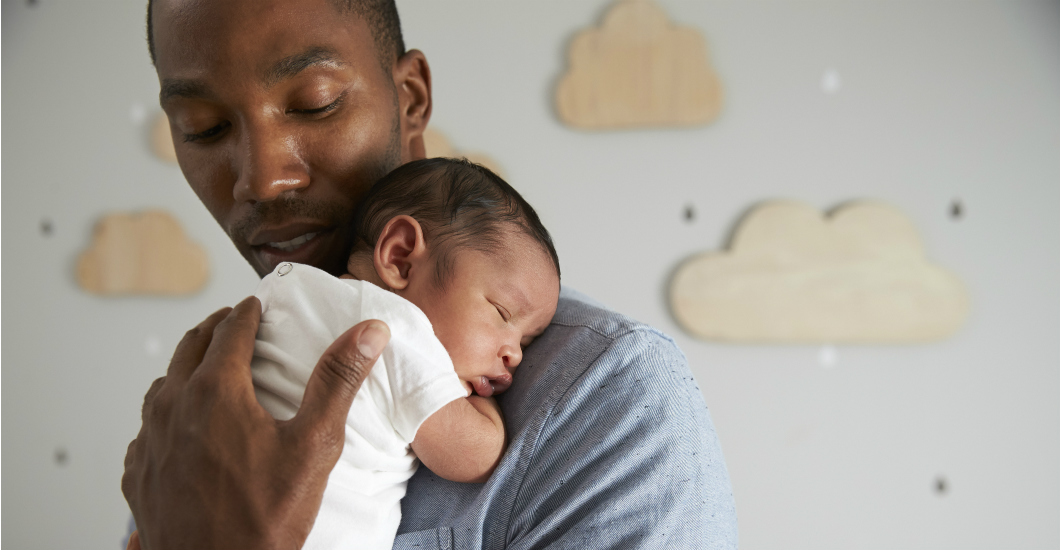- Home |
- Search Results |
- Dream feeding: tips and tricks for parents

The concept of a dream feed may be new to you. No doubt it’s one of those phrases that was unfamiliar before becoming a parent, but now you may be considering whether or not to feed your baby while they’re asleep – and asking what benefits that might bring.
Like most parenting decisions, there's a lot of advice about dream feeding. While many swear it helps your new arrival sleep for longer stretches, others think it disrupts their sleep patterns. It’s important to remember that what works for one family may not work for another. If you are considering whether to give dream feeding a go, this guide will help you understand why you might want to try it, and how to put it into practice. We’ve rounded up some of the best blogs on the subject to help you consider the pros and cons of dream feeding.
What is a dream feed?
A dream feed is where you give your baby an extra helping of milk late in the evening before they have woken up for a night feed. The idea is that feeding them before they naturally wake encourages them to sleep for longer because they are fuller. It can also be useful for babies that don't feed much during the day because they are likely to drink more.

How do you perform a dream feed?
There are two ways of giving your baby a dream feed.
Some wake their babies. You might do this by picking them up, lightly tickling their cheek, changing positions, stroking their palm or foot – anything that rouses them gently. Other mums, including Rachel from My Baby Sleep Guide and Orlena from Snotty Noses, suggest changing their nappy before a feed in order to wake them. This has two advantages:
1. They are awake enough to feed properly but (hopefully) sleepy enough to drop off again
2. They have a clean nappy, so you don’t have to worry about any leaks caused by the extra milk
On the other hand, some practitioners favour literally feeding your baby while they are asleep. This is the original definition of a dream feed – Baby Sleep Trainer Natalie Willes maintains that a dream feed is not a dream feed if the baby opens their eyes – and it is the approach used by paediatric sleep consultants Wee Bee Dreaming. In this case, you would just put the nipple or teat to the baby’s lips. Sometimes this is enough to begin a feed as it stimulates the rooting reflex, but if not then you can encourage them to latch or suck by stroking their cheek or chest.
If you are waking your baby, you can feed them in your usual spot before returning them to the crib. If you are trying not to wake your baby, some choose to perform the feed without even lifting them – this may be easier if you are using a bottle when you might prop the baby up on a pillow so they remain upright.
So, which method works best?
It really depends on your baby. Some will object to being woken and so respond better to the feeding-while-asleep method. Others may be so fast asleep that they simply will not latch or suck unless you wake them first. Even then, some may prefer to go back to sleep.
If this does happen, it is worth persevering for a few days as it can take a little while to make dream feeding a routine for both you and your little one. However, if your baby is repeatedly too sleepy to feed, it may be that dream feeds are not right for them - and that’s ok!
Should you wind your baby after a dream feed?
It is not usually necessary to wind your baby after a dream feed. Wee Bee Dreaming explains that this is because your baby is so relaxed during this feed that they are less likely to gulp or take in extra air.
However, if you are concerned that your baby may need winding – or if they have a condition like reflux, which means you would usually keep them upright – then you may be better lifting them out of the cot to perform the feed. Rachel of My Baby Sleep Guide recommends burping younger babies, so do what is best for you and your baby.

What else should I consider?
Whether or not you wake your baby, make sure you keep their room as dark, calm, and quiet as possible and perform the dream feed quickly. Once you have finished, put them back and let them carry on sleeping.
Why should I dream feed?
Many baby books — including those by Baby Whisperer author Tracy Hogg, who coined the phrase ‘dream feed,’ and Save Our Sleep author Tizzie Hall — say the dream feed helps babies sleep for longer periods.
Veena V of the blog Mum to Millionaire explains that this is because babies tend to have one long stretch of sleep in 24 hours. By giving them a dream feed, you are encouraging that long sleep to happen when you yourself are also asleep. In other words, you are preparing them to sleep through the night, although this won’t happen straight away — depending on their age and weight young babies are still going to wake for another feed or even two, but the hope is that the dream feed will push those wakings later and later. The idea is that they will eventually sleep from the dream feed until the morning (although mornings may still start early!)
Why should I NOT dream feed?
Some midwives, sleep practitioners and bloggers — including those behind the Seacoast Mom’s Blog and Mumfidential — say dream feeds do not promote longer stretches of sleep. They maintain that introducing a dream feed actually interrupts a baby’s natural cycle, which leads to fragmented sleep and possibly even more wakings. Some also believe that a dream feed encourages babies to develop a habit they wouldn't otherwise have.
The only way to see whether it might work for your family is to give it a go. Most bloggers and experts agree that if you do try a dream feed, you need to allow a few nights before you decide whether or not it’s working. It can take a while to establish, but for some — including blogger the Unique Mum — once your baby gets it, it really helps.
What time should I offer a dream feed?
The time to offer a dream feed is before you go to bed, so you get a longer stretch of sleep at the beginning of the night. For most parents, this is between 10 and 11pm. It’s usually around 3-4 hours after the previous milk feed, depending on the age of the baby.
Is it best for bottle or breastfed babies?
Either. Dream feeds are possible for breastfeeding Mums as well as bottle-feeding parents and carers. Milk can be given directly from the breast; expressed and given by bottle, or made up with your usual formula. How the baby takes to the dream feed will depend more on them than on your feeding method.
The main thing to note if you are doing a dream feed from the breast is that exclusively breastfed babies sometimes need a little more encouragement to latch. You will also need to consider which position is most comfortable for you, which means you are more likely to want to move your baby in order to feed them.
If you prefer not to wake your baby it may be slightly easier to perform a dream feed with a bottle, because you don’t have to lift your baby out of the crib. As those at Wee Bee Dreaming point out, it also makes it easier for dad or another carer to get involved, although breastfeeding mums may want to consider whether not performing the feed themselves is likely to impact their supply.
To alleviate this, some breastfeeding mums choose to pump before bed, then give the expressed milk to their partner or other carer so that they can perform the feed. Mum is then free to go to bed as early as she likes!

How old should my baby be when I start offering a dream feed?
Most specialists say that the earlier you introduce a dream feed, the more likely it is to work. However, when your baby is very young, it is better to go with their feeding schedule.
Save our Sleep author Tizzie Hall recommends introducing the dream feed at eight weeks. Somewhere between two and three months old is common. Wee Bee Dreaming suggests that there is little point beginning a dream feed on a baby older than four months, as that is the point at which their sleep patterns start to change.
When and how should I drop the dream feed?
Baby Whisperer author Tracy Hogg, Contented Baby author Gina Ford, Wee Bee Dreaming, and many other practitioners suggest dropping the dream feed when solid foods have been established, usually between six and eight months old. However, others suggest it can be stopped earlier. It may be that your baby starts to take less, and so naturally drops it themselves.
Whatever you decide, Rachel of My Baby Sleep Guide suggests a few possible methods for dropping the dream feed:
- You can stop straight away, although this may result in more night wakings
- You can reduce the amount you give gradually – if you are breastfeeding, reduce the time spent and if you are bottle-feeding, reduce the number of ounces
- You can slowly move the time of the dream feed earlier so that eventually it is close enough to the bedtime feed to be dropped
Does a dream feed always work?
No, because it does depend on your baby. Some may refuse to feed, others may wake and be hard to get back to sleep, and others may take feed fine but still wake as often as they were before. If you have tried it for a week or more and it is not working for you, it’s probably better not to persevere.
What are the pros and cons?
There’s a lot of information to consider, so to finish off we’ve summarised the main advantages and disadvantages of dream feeding your baby:
Pros
- Many parents say it has helped their babies sleep for longer stretches at night
- If another carer gives the feed, mum is able to go to bed earlier and get a longer stretch of sleep
- For babies that don’t feed much during the day, it provides additional calories
Cons
- Some believe dream feeds disrupt babies’ natural sleep patterns
- It is possible that offering a dream feed may create a habit that wouldn't be there otherwise, and it may be hard to establish when your baby is ready to sleep without it
- It doesn't work for every baby – some may not respond to it at all, and others may become distressed
So whether you both take to dream feeding, or whether it’s not for you, the most important thing is to do what works for you - and your little one.